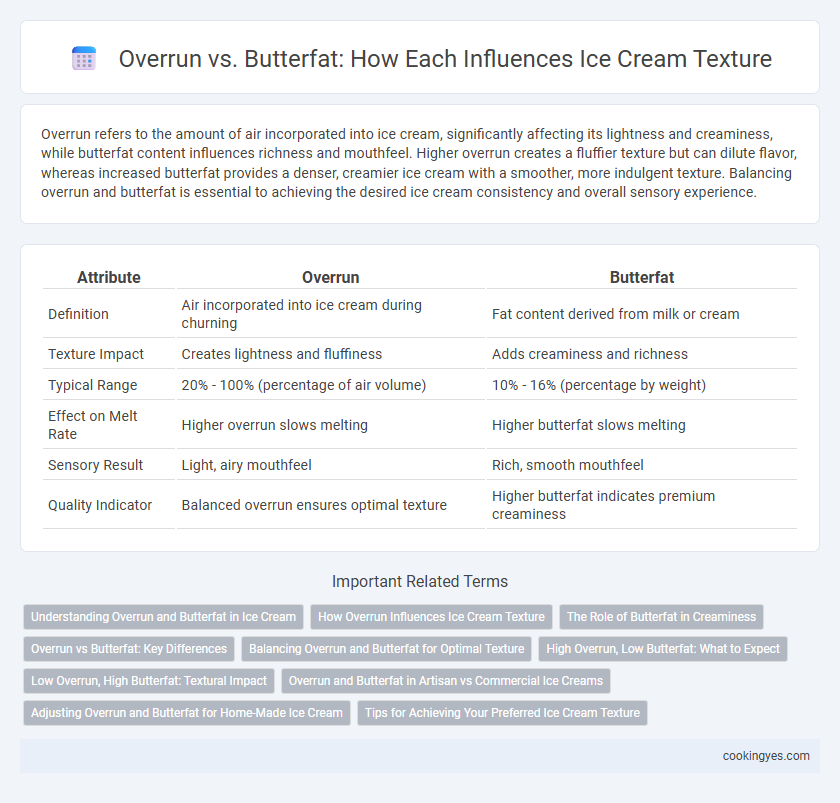Overrun refers to the amount of air incorporated into ice cream, significantly affecting its lightness and creaminess, while butterfat content influences richness and mouthfeel. Higher overrun creates a fluffier texture but can dilute flavor, whereas increased butterfat provides a denser, creamier ice cream with a smoother, more indulgent texture. Balancing overrun and butterfat is essential to achieving the desired ice cream consistency and overall sensory experience.
Table of Comparison
| Attribute | Overrun | Butterfat |
|---|---|---|
| Definition | Air incorporated into ice cream during churning | Fat content derived from milk or cream |
| Texture Impact | Creates lightness and fluffiness | Adds creaminess and richness |
| Typical Range | 20% - 100% (percentage of air volume) | 10% - 16% (percentage by weight) |
| Effect on Melt Rate | Higher overrun slows melting | Higher butterfat slows melting |
| Sensory Result | Light, airy mouthfeel | Rich, smooth mouthfeel |
| Quality Indicator | Balanced overrun ensures optimal texture | Higher butterfat indicates premium creaminess |
Understanding Overrun and Butterfat in Ice Cream
Overrun in ice cream refers to the amount of air whipped into the mixture, typically expressed as a percentage of the original volume, which significantly affects creaminess and volume. Butterfat content, derived from milk and cream, plays a crucial role in delivering richness, smooth texture, and mouthfeel. Balancing high overrun with adequate butterfat levels ensures a light yet creamy texture, optimizing the sensory experience of ice cream.
How Overrun Influences Ice Cream Texture
Overrun, the amount of air incorporated into ice cream during churning, significantly influences its texture by creating a lighter, creamier mouthfeel and reducing density. Higher overrun results in a fluffier, softer product, while lower overrun produces a denser, richer texture. Butterfat content complements overrun by enhancing creaminess and smoothness, but overrun primarily determines the ice cream's volume and overall texture balance.
The Role of Butterfat in Creaminess
Butterfat significantly influences ice cream creaminess by contributing to a rich, smooth texture and enhancing mouthfeel through fat globule structure. The amount of butterfat determines the cream's ability to coat the tongue and provide a luscious sensation, distinguishing premium ice cream from lower-fat varieties. Balancing butterfat with overrun is crucial in texture optimization, as excessive overrun can dilute creaminess despite high fat content.
Overrun vs Butterfat: Key Differences
Overrun measures the amount of air incorporated into ice cream, directly affecting its volume and creaminess, while butterfat content determines richness and mouthfeel by contributing to fat concentration. Higher overrun creates a lighter, fluffier texture with less density, whereas increased butterfat results in a denser, creamier product with a more luxurious taste. Balancing overrun and butterfat is crucial for achieving the desired ice cream texture, as excessive overrun can dilute flavor despite a high butterfat percentage.
Balancing Overrun and Butterfat for Optimal Texture
Balancing overrun and butterfat is essential for achieving the perfect ice cream texture, as overrun controls the amount of air incorporated and directly affects creaminess and density. Butterfat contributes to richness and smoothness, with higher fat content enhancing mouthfeel but potentially reducing the lightness created by optimal overrun levels. Properly adjusting both elements ensures a creamy yet airy ice cream that maintains structural integrity and desirable melt resistance.
High Overrun, Low Butterfat: What to Expect
High overrun in ice cream increases air content, resulting in a lighter, fluffier texture, while low butterfat reduces creaminess and richness. This combination often produces a more delicate mouthfeel with less intense flavor and smoothness compared to higher butterfat versions. Ice creams with high overrun and low butterfat appeal to those seeking a lower-fat treat without sacrificing volume, though they may lack the luxurious mouth-coating quality of traditional, cream-heavy recipes.
Low Overrun, High Butterfat: Textural Impact
Low overrun in ice cream means less air is incorporated, resulting in a denser and creamier texture. High butterfat content enhances richness and smoothness, providing a luxurious mouthfeel. Together, low overrun and high butterfat create an indulgent, velvety ice cream with superior depth and body.
Overrun and Butterfat in Artisan vs Commercial Ice Creams
Overrun and butterfat content critically shape the texture of ice cream, with artisan varieties typically featuring lower overrun and higher butterfat than commercial counterparts. Artisan ice creams with 25-50% overrun offer denser, creamier textures due to increased butterfat levels, usually around 14-18%, which enhance mouthfeel and flavor richness. Commercial ice creams commonly have 50-100% overrun, creating lighter, airier textures but with lower butterfat ranging from 10-14%, resulting in a less creamy consistency.
Adjusting Overrun and Butterfat for Home-Made Ice Cream
Adjusting overrun and butterfat levels significantly impacts the texture of home-made ice cream, where overrun refers to the amount of air incorporated during churning and butterfat determines creaminess and mouthfeel. Increasing overrun creates lighter, fluffier ice cream, while higher butterfat content yields a richer, smoother texture by reducing ice crystal size. Balancing these factors allows home ice cream makers to customize firmness, creaminess, and melting properties for a premium dessert experience.
Tips for Achieving Your Preferred Ice Cream Texture
Overrun, the amount of air incorporated into ice cream, directly affects its lightness and creaminess, while butterfat content influences richness and mouthfeel; balancing these factors is key for your ideal texture. Aim for an overrun between 20-50% to avoid overly dense or overly airy results and adjust butterfat levels from 10% to 16% to achieve a smooth, creamy consistency without greasiness. Experimenting with small batch recipes and precise measurements ensures consistent texture tailored to personal preference.
Overrun vs butterfat for ice cream texture Infographic

 cookingyes.com
cookingyes.com